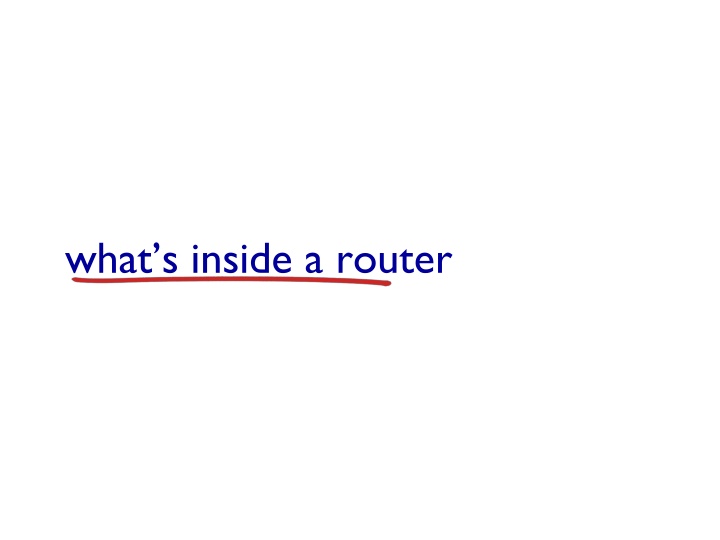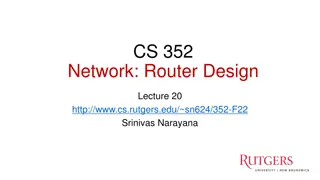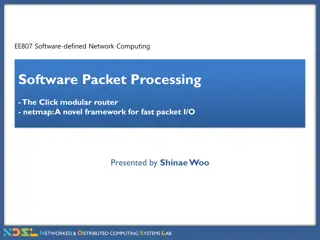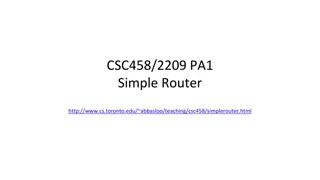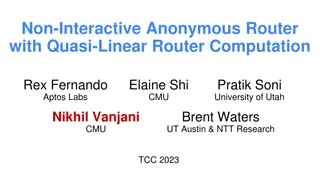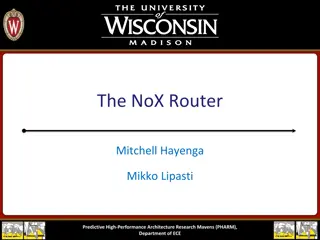what’s inside a router
Routers are essential networking devices that help transfer data between computer networks. Inside a router, you'll find components like processors, memory, and interfaces that enable communication between devices. Understanding the inner workings of a router can help you troubleshoot issues and optimize your network performance. Dive into the world of routers and discover how these devices facilitate seamless data transmission in your network.
Download Presentation

Please find below an Image/Link to download the presentation.
The content on the website is provided AS IS for your information and personal use only. It may not be sold, licensed, or shared on other websites without obtaining consent from the author.If you encounter any issues during the download, it is possible that the publisher has removed the file from their server.
You are allowed to download the files provided on this website for personal or commercial use, subject to the condition that they are used lawfully. All files are the property of their respective owners.
The content on the website is provided AS IS for your information and personal use only. It may not be sold, licensed, or shared on other websites without obtaining consent from the author.
E N D
Presentation Transcript
Router architecture overview two key router functions: run routing algorithms/protocol (RIP, OSPF, BGP) forwarding datagrams from incoming to outgoing link routing processor forwarding tables computed, pushed to input ports routing, management control plane (software) forwarding data plane (hardware) high-seed switching fabric router input ports router output ports
Input port functions lookup, forwarding link layer protocol (receive) switch fabric line termination queueing physical layer: bit-level reception decentralized switching: given datagram dest., lookup output port using forwarding table in input port memory ( match plus action ) goal: complete input port processing at line speed queuing: if datagrams arrive faster than forwarding rate into switch fabric data link layer: e.g., Ethernet see chapter 5
Switching fabrics transfer packet from input buffer to appropriate output buffer switching rate: rate at which packets can be transfer from inputs to outputs often measured as multiple of input/output line rate N inputs: switching rate N times line rate desirable three types of switching fabrics memory bus memory crossbar
Switching via memory first generation routers: traditional computers with switching under direct control of CPU packet copied to system s memory speed limited by memory bandwidth (2 bus crossings per datagram) output port (e.g., Ethernet) input port (e.g., Ethernet) memory system bus
Switching via a bus datagram from input port memory to output port memory via a shared bus bus contention: switching speed limited by bus bandwidth 32 Gbps bus, Cisco 5600: sufficient speed for access and enterprise routers bus
Switching via interconnection network overcome bus bandwidth limitations banyan networks, crossbar, other interconnection nets initially developed to connect processors in multiprocessor advanced design: fragmenting datagram into fixed length cells, switch cells through the fabric. Cisco 12000: switches 60 Gbps through the interconnection network crossbar
Output ports datagram buffer link layer protocol (send) switch fabric line termination queueing buffering required when datagrams arrive from fabric faster than the transmission rate scheduling discipline chooses among queued datagrams for transmission
Output port queueing switch fabric switch fabric one packet time later at t, packets more from input to output buffering when arrival rate via switch exceeds output line speed queueing (delay) and loss due to output port buffer overflow!
Input port queuing fabric slower than input ports combined -> queueing may occur at input queues queueing delay and loss due to input buffer overflow! Head-of-the-Line (HOL) blocking: queued datagram at front of queue prevents others in queue from moving forward switch fabric switch fabric output port contention: only one red datagram can be transferred. lower red packet is blocked one packet time later: green packet experiences HOL blocking
routing algorithms link state distance vector hierarchical routing
Interplay between routing, forwarding routing algorithm determines end-end-path through network routing algorithm forwarding table determines local forwarding at this router local forwarding table dest address output link 3 2 2 1 address-range 1 address-range 2 address-range 3 address-range 4 IP destination address in arriving packet s header 1 3 2
Graph abstraction 5 3 v w 5 2 u z 2 1 3 1 2 x y 1 graph: G = (N,E) N = set of routers = { u, v, w, x, y, z } E = set of links ={ (u,v), (u,x), (v,x), (v,w), (x,w), (x,y), (w,y), (w,z), (y,z) } aside: graph abstraction is useful in other network contexts, e.g., P2P, where N is set of peers and E is set of TCP connections
Graph abstraction: costs 5 c(x,x ) = cost of link (x,x ) e.g., c(w,z) = 5 3 v w 5 2 cost could always be 1, or inversely related to bandwidth, or inversely related to congestion u z 2 1 3 1 2 x y 1 cost of path (x1, x2, x3, , xp) = c(x1,x2) + c(x2,x3) + + c(xp-1,xp) key question: what is the least-cost path between u and z ? routing algorithm: algorithm that finds that least cost path
Routing algorithm classification Q: Centralized or decentralized information? Centralized: all routers have complete topology, link cost info link state algorithms decentralized: router knows physically- connected neighbors, link costs to neighbors iterative process of computation, exchange of info with neighbors distance vector algorithms Q: static or dynamic? static: routes change slowly over time dynamic: routes change more quickly periodic update in response to link cost changes
Hierarchical routing our routing study thus far - idealization all routers identical network flat not true in practice scale: with 600 million destinations: can t store all dest s in routing tables! routing table exchange would swamp links! administrative autonomy internet = network of networks each network admin may want to control routing in its own network
Hierarchical routing aggregate routers into regions, autonomous systems (AS) routers in same AS run same routing protocol intra-AS routing protocol routers in different AS can run different intra-AS routing protocol gateway router: at edge of its own AS has link to router in another AS
Interconnected ASes 3c 3a 2c 3b 2a AS3 2b 1c AS2 1a 1b AS1 1d forwarding table configured by both intra- and inter-AS routing algorithm intra-AS sets entries for internal dests inter-AS & intra-AS sets entries for external dests Intra-AS Routing algorithm Inter-AS Routing algorithm Forwarding table
Inter-AS tasks suppose router in AS1 receives datagram destined outside of AS1: router should forward packet to gateway router, but which one? AS1 must: 1. learn which dests are reachable through AS2, which through AS3 2. propagate this reachability info to all routers in AS1 job of inter-AS routing! 3c 3a 3b 2c AS3 other networks 1c 2a 2b other networks 1a 1b AS2 1d AS1
Example: setting forwarding table in router 1d suppose AS1 learns (via inter-AS protocol) that subnet x reachable via AS3 (gateway 1c), but not via AS2 inter-AS protocol propagates reachability info to all internal routers router 1d determines from intra-AS routing info that its interface I is on the least cost path to 1c installs forwarding table entry (x,I) x 3c 3a 3b 2c AS3 other networks 1c 2a 2b other networks 1a 1b AS2 1d AS1
Example: choosing among multiple ASes now suppose AS1 learns from inter-AS protocol that subnet x is reachable from AS3 and from AS2. to configure forwarding table, router 1d must determine which gateway it should forward packets towards for dest x this is also job of inter-AS routing protocol! x 3c 3a 3b 2c AS3 other networks 1c 2a 2b other networks 1a 1b AS2 1d AS1 ?
Example: choosing among multiple ASes now suppose AS1 learns from inter-AS protocol that subnet x is reachable from AS3 and from AS2. to configure forwarding table, router 1d must determine towards which gateway it should forward packets for dest x this is also job of inter-AS routing protocol! hot potato routing: send packet towards closest of two routers. determine from forwarding table the interface I that leads to least-cost gateway. Enter (x,I) in forwarding table use routing info from intra-AS protocol to determine costs of least-cost paths to each of the gateways learn from inter-AS protocol that subnet x is reachable via multiple gateways hot potato routing: choose the gateway that has the smallest least cost
routing in the Internet RIP OSPF BGP
Intra-AS Routing also known as interior gateway protocols (IGP) most common intra-AS routing protocols: RIP: Routing Information Protocol OSPF: Open Shortest Path First IGRP: Interior Gateway Routing Protocol (Cisco proprietary)
RIP ( Routing Information Protocol) distance vector algorithm distance metric: # hops (max = 15 hops), each link has cost 1 DVs exchanged with neighbors every 30 sec in response message (aka advertisement) each advertisement: list of up to 25 destination subnets (in IP addressing sense) from router A to destination subnets: u subnet hops u 1 v 2 w 2 x 3 y 3 z 2 v w A B x C D z y
OSPF (Open Shortest Path First) open : publicly available uses link state algorithm LS packet dissemination topology map at each node route computation using Dijkstra s algorithm OSPF advertisement carries one entry per neighbor advertisements flooded to entire AS carried in OSPF messages directly over IP (rather than TCP or UDP IS-IS routing protocol: nearly identical to OSPF
OSPF advanced features (not in RIP) security: all OSPF messages authenticated (to prevent malicious intrusion) multiple same-cost paths allowed (only one path in RIP) for each link, multiple cost metrics for different TOS (e.g., satellite link cost set low for best effort ToS; high for real time ToS) integrated uni- and multicast support: Multicast OSPF (MOSPF) uses same topology data base as OSPF hierarchical OSPF in large domains.
Why different Intra-, Inter-AS routing ? policy: inter-AS: admin wants control over how its traffic routed, who routes through its net. intra-AS: single admin, so no policy decisions needed scale: hierarchical routing saves table size, reduced update traffic performance: intra-AS: can focus on performance inter-AS: policy more important than performance
Broadcast routing deliver packets from source to all other nodes source duplication is inefficient: duplicate duplicate R1 R1 creation/transmission duplicate R2 R2 R3 R4 R3 R4 in-network duplication source duplication source duplication: how does source determine recipient addresses?
In-network duplication flooding: when node receives broadcast packet, sends copy to all neighbors problems: cycles & broadcast storm controlled flooding: node only broadcasts pkt if it hasn t broadcast same packet before node keeps track of packet ids already broadacsted or reverse path forwarding (RPF): only forward packet if it arrived on shortest path between node and source spanning tree: no redundant packets received by any node
Spanning tree first construct a spanning tree nodes then forward/make copies only along spanning tree A A B B c c D D E F E F G G (b) broadcast initiated at D (a) broadcast initiated at A
Multicast routing: problem statement goal: find a tree (or trees) connecting routers having local mcast group members tree:not all paths between routers used shared-tree:same tree used by all group members source-based:different tree from each sender to rcvrs legend group member not group member router with a group member router without group member shared tree source-based trees
Approaches for building mcast trees approaches: source-based tree: one tree per source shortest path trees reverse path forwarding group-shared tree: group uses one tree minimal spanning (Steiner) center-based trees
